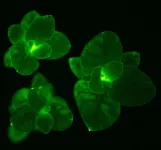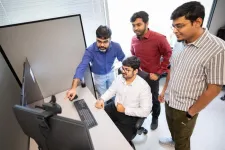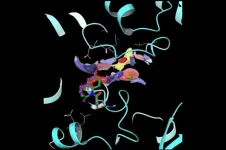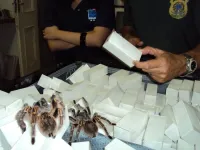(Press-News.org) In a striking new study published today in Science Advances, a team of synthetic biologists led by Karen Sarkisyan at the MRC Laboratory of Medical Sciences, have reported the discovery of multiple plant enzymes – hispidin synthases – that can perform the most complex reaction of the bioluminescence pathway. This discovery is a significant milestone towards figuring out whether plants can natively produce all the molecules required for light emission. It also means that the glow of bioluminescent plants can now be more closely aligned with their internal biology.
The technology reported in the paper is a hybrid pathway that couples the newly found plant hispidin synthases to other necessary bioluminescence enzymes found in mushrooms. This hybrid pathway allows the subtle inner rhythms and dynamics within plants to be unveiled as an ever-changing display of living light. “This technology is a plug-and-play tool to visualise virtually any molecular physiology at the organismal level, completely non-invasively” Sarkisyan states. His work also revealed that not only does a single indigenous plant gene effectively substitute for two fungal genes, the plant gene is notably smaller and has simpler biological requirements for luminescence. The gene's reduced size also enhances its usability and flexibility, making it more adaptable for extended applications.
This research was sponsored by Light Bio, a plant synthetic biology company co-founded by Sarkisyan, which aims to transform the horticulture industry with beautiful biotech creations, such as glowing plants. The first product to exploit the hispidin-based pathway is Firefly Petunia, so named because its bright light-emitting flower buds resemble fireflies.
Beyond the advances in aesthetics that luminous vegetation may provide to plant-lovers, the foundational science offers profound insights into plant molecular physiology. By enabling continuous monitoring of plant responses to various stresses, such as drought stress or attacks by pests, the technology may lead to significant progress in fields such as crop development and disease resistance.
Sarkysian’s bioluminescence pathway has been replicated in other species including yeast and even in human cells. “We love growing our bioluminescent petunias, they are truly magical. But beyond aesthetics, understanding how we can adapt self-sustained luminescence to monitor disease progression and assist in the screening of drug candidates will make this technology even more impactful”, says Sarkysian.
END
Harnessing the mechanisms of fungal bioluminescence to confer autonomous luminescence in plants and animal cells
Many tropical mushroom species glow in the dark. When scientists discovered the mechanism of luminescence, they found similarity to healthy plant metabolism. New research reveals plants might possess the native capability to emit light themselves
2024-03-08
ELSE PRESS RELEASES FROM THIS DATE:
New study discovers how altered protein folding drives multicellular evolution
2024-03-08
Researchers have discovered a mechanism steering the evolution of multicellular life. They identified how altered protein folding drives multicellular evolution.
In a new study led by researchers from the University of Helsinki and the Georgia Institute of Technology, scientists turned to a tool called experimental evolution. In the ongoing Multicellularity Long Term Evolution Experiment (MuLTEE), laboratory yeast are evolving novel multicellular functions, enabling researchers to investigate how they arise.
The study puts the spotlight on the regulation of proteins in understanding evolution.
"By demonstrating the effect of protein-level ...
Socially prescribed creative play boosts parents’ and children’s wellbeing
2024-03-08
University of Leeds news
For immediate release
Socially prescribed creative play boosts parents’ and children’s wellbeing
Socially prescribed creative play helps children and their parents develop new skills and promotes wellbeing, a new study has found.
The University of Leeds-led study evaluated a five-week programme of arts-based play, including singing and music-making, for families of children aged up to three. It found that parents benefited from developing social networks and sharing experiences with each other, as well as learning creative approaches to parenting. ...
Researchers’ approach may protect quantum computers from attacks
2024-03-08
Quantum computers, which can solve several complex problems exponentially faster than classical computers, are expected to improve artificial intelligence (AI) applications deployed in devices like autonomous vehicles; however, just like their predecessors, quantum computers are vulnerable to adversarial attacks.
A team of University of Texas at Dallas researchers and an industry collaborator have developed an approach to give quantum computers an extra layer of protection against such attacks. Their solution, Quantum Noise Injection for Adversarial Defense (QNAD), counteracts the impact of ...
Rogue enzymes cause numerous diseases. A new method could help design drugs to treat them.
2024-03-08
Helicases are enzymes that unwind DNA and RNA. They’re central to cellular life, implicated in a number of cancers and infections—and, alas, extraordinarily difficult to target with drugs.
Now, new research provides a powerful platform for designing covalent inhibitors tailored to target helicases. The paper, published in the Journal of the American Chemical Society, describes how researchers used this innovative new platform to design molecules that take aim at helicases involved in COVID and certain cancers.
“High-resolution structural and biochemical data alone are not sufficient ...
Study shows how oestrogen protects against fatty liver
2024-03-08
New research from Karolinska Institutet in Sweden shows how oestrogen protects against MASLD, a fatty liver disease that has increased dramatically during the current obesity epidemic. The study, published in Molecular Systems Biology, shows how a new drug under development could become a future treatment for fatty liver disease and liver cancer.
The global obesity epidemic has resulted in a dramatic increase in fatty liver, a disease in which fat that does not fit into fat cells is stored in liver cells instead.
Since last year, fatty liver due to obesity (and not excessive alcohol consumption) is known as MASLD (metabolic dysfunction-associated steatotic liver disease). ...
Limited correlation between canine lymphoma and proximity to environmental toxins in new study
2024-03-08
DENVER/March 8, 2024 – As awareness of the health risks associated with radon and fracking exposure in connection to cancer continues to rise in human medicine, a recent study explored these ties with multicentric lymphoma, a prevalent canine cancer. Surprisingly, the study did not identify significant correlations between living near sources of environmental toxins, such as fracking by-products and radon, and dogs diagnosed with lymphoma.
The results of this study were published on Monday using data from Morris Animal Foundation’s Golden Retriever Lifetime Study, which enrolled dogs with multicentric lymphoma and matched unaffected ...
Bald eagles eat prairie dogs? Researchers underscore relationship between raptors and rodents in the southern plains
2024-03-08
We all know that bald eagles like fish. Few of us, however, picture them soaring over grasslands seeking out prairie dog snacks. In a new paper from the Journal of Raptor Research, lead author Courtney Duchardt and coauthors make the case that prairie dogs are an important resource for at least four species of raptors overwintering in the Southern Great Plains, bald eagles included. Their paper, titled “Overwintering Raptor Abundance and Community Composition in Relation to Prairie Dog Colonies in the Southern Great Plains,” explains the first broad scale look into the relationship between prairie dogs and their aerial predators, and illuminates ...
Facing illegal wildlife trade in the European union: A call for comprehensive measures
2024-03-08
New paper now published in Science proposes three measures the European Union should implement to improve open information, legality and sustainability of wildlife trade in the region.
Wildlife trade affects all kinds of species, from insects and fungi to large plants and mammals. The global trade of numerous species poses a significant threat to their survival, increasing their risk of extinction. The European Union is a major global hub for the illegal and unsustainable trade of those species whose international trade is not regulated by the Convention on International Trade in Endangered ...
A better handle on the emissions budget for the Paris climate targets
2024-03-08
A team of scientists from the University of Exeter, Met Office and Imperial College have found a new way to calculate the total carbon emissions consistent with the Paris climate targets of 1.5oC and 2oC of global warming.
Although the exceptionally warm climate in 2023 was close to exceeding the 1.5oC level, the Paris targets relate to the average warming over ten or more years.
The new study answers the question: how much carbon have we got left before we pass the Paris limits?
About 15 years ago, climate scientists discovered a remarkably useful fact about climate change.
Despite the vast complexity ...
High cholesterol was twice as prevalent among American Indian teens and young adults
2024-03-08
Research Highlights:
A study of more than 1,400 people in U.S. tribal communities found that high cholesterol was twice as prevalent among American Indian adolescents and young adults compared to the overall U.S. population.
The study also noted that few study participants with high cholesterol sought or received treatment during the study period.
DALLAS, March 8, 2024 — Young American Indians, ages 15-39, had cholesterol levels more than two times higher than the general U.S. population, according to new research published in the Journal of the American Heart Association, an open access, peer-reviewed journal of the American ...
LAST 30 PRESS RELEASES:
Decoupling the HOR enhancement on PtRu: Dynamically matching interfacial water to reaction coordinates
Sulfur isn’t poisonous when it synergistically acts with phosphine in olefins hydroformylation
URI researchers uncover molecular mechanisms behind speciation in corals
Chitin based carbon aerogel offers a cleaner way to store thermal energy
Tracing hidden sources of nitrate pollution in rapidly changing rural urban landscapes
Viruses on plastic pollution may quietly accelerate the spread of antibiotic resistance
Three UH Rainbow Babies & Children’s faculty elected to prestigious American Pediatric Society
Tunnel resilience models unveiled to aid post-earthquake recovery
Satellite communication systems: the future of 5G/6G connectivity
Space computing power networks: a new frontier for satellite technologies
Experiments advance potential of protein that makes hydrogen sulfide as a therapeutic target for Alzheimer’s disease
Examining private equity’s role in fertility care
Current Molecular Pharmacology achieves a landmark: real-time CiteScore advances to 7.2
Skeletal muscle epigenetic clocks developed using postmortem tissue from an Asian population
Estimating unemployment rates with social media data
Climate policies can backfire by eroding “green” values, study finds
Too much screen time too soon? A*STAR study links infant screen exposure to brain changes and teen anxiety
Global psychiatry mourns Professor Dan Stein, visionary who transformed mental health science across Africa and beyond
KIST develops eco-friendly palladium recovery technology to safeguard resource security
Statins significantly reduce mortality risk for adults with diabetes, regardless of cardiovascular risk
Brain immune cells may drive more damage in females than males with Alzheimer’s
Evidence-based recommendations empower clinicians to manage epilepsy in pregnancy
Fungus turns bark beetles’ defenses against them
There are new antivirals being tested for herpesviruses. Scientists now know how they work
CDI scientist, colleagues author review of global burden of fungus Candida auris
How does stroke influence speech comprehension?
B cells transiently unlock their plasticity, risking lymphoma development
Advanced AI dodel predicts spoken language outcomes in deaf children after cochlear implants
Multimodal imaging-based cerebral blood flow prediction model development in simulated microgravity
Accelerated streaming subgraph matching framework is faster, more robust, and scalable
[Press-News.org] Harnessing the mechanisms of fungal bioluminescence to confer autonomous luminescence in plants and animal cellsMany tropical mushroom species glow in the dark. When scientists discovered the mechanism of luminescence, they found similarity to healthy plant metabolism. New research reveals plants might possess the native capability to emit light themselves








